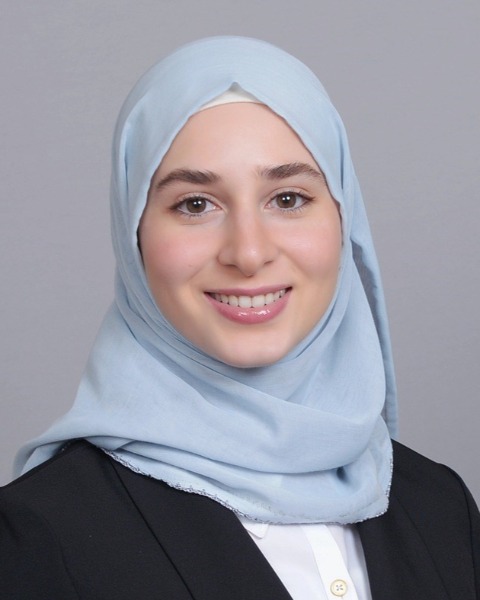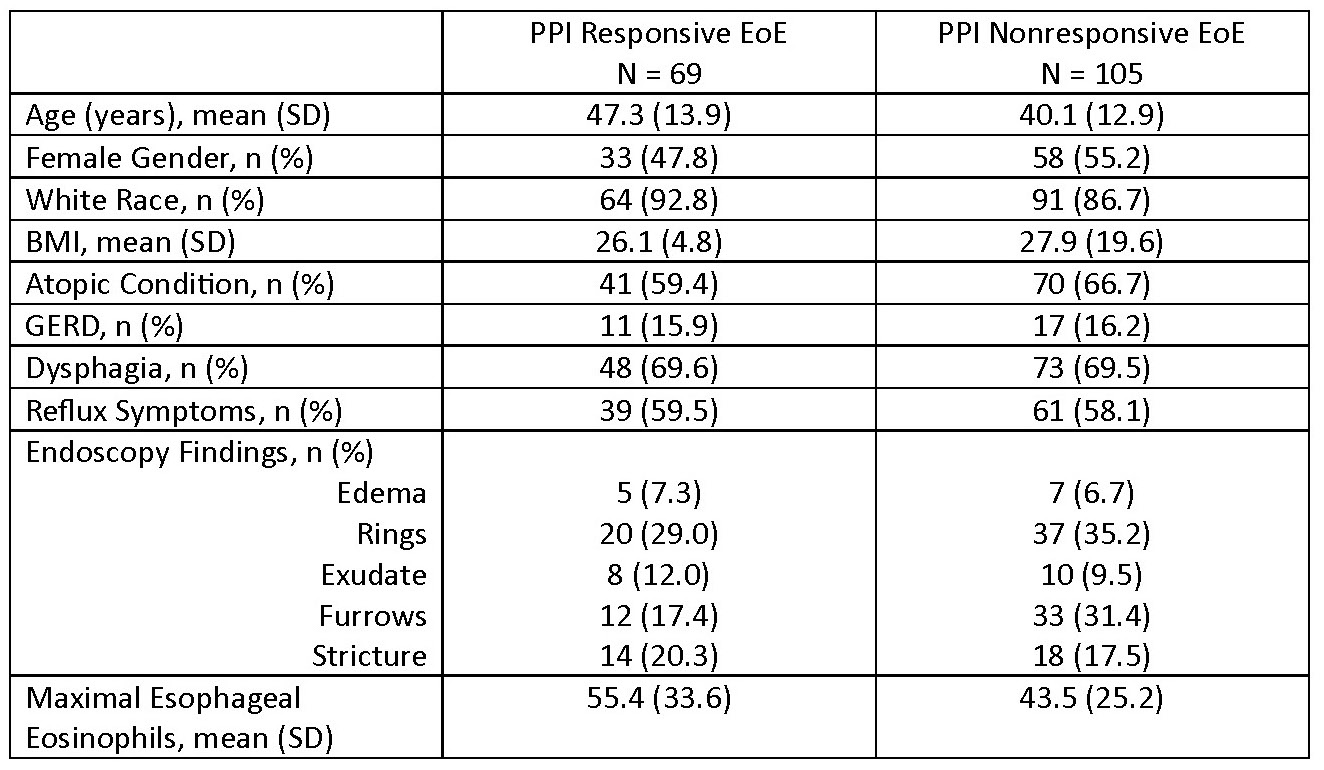Sunday Poster Session
Category: Esophagus
P0642 - Baseline Absolute Eosinophil Count Independently Predicts Complete Histologic Response to Proton Pump Inhibitors in Eosinophilic Esophagitis
Sunday, October 26, 2025
3:30 PM - 7:00 PM PDT
Location: Exhibit Hall

Rama Nassri, MD
Mass General Brigham
Salem, Massachusetts
Presenting Author(s)
Mayssan Muftah, MD, MPH1, Rama Nassri, MD2, Davis Hartnett, MD1, Karen Kwaning, MD, MPH1, Brent Hiramoto, MD, MPH3, Walter Chan, MD, MPH, FACG4
1Brigham and Women's Hospital, Harvard Medical School, Boston, MA; 2Mass General Brigham, Salem, MA; 3University of Southern California, Boston, MA; 4Brigham and Women's Hospital, Boston, MA
Introduction: Around 50% of patients with eosinophilic esophagitis (EoE) respond to proton pump inhibitors (PPI), however it is difficult to predict response to PPI at EoE diagnosis. Prior data suggests that serum absolute eosinophil counts (AEC) can predict histologic response to PPI (< 15 eos/hpf). Our goal was to evaluate how baseline serum AEC can predict other histologic and symptom treatment outcomes following PPI therapy.
Methods: This is a retrospective study of adult EoE patients from 2016–2021 at 3 hospitals (2 community, 1 tertiary) that completed ≥8 weeks of PPI therapy (at least 40mg daily dose) with subsequent EGD to assess response. Included patients had a complete blood cell count with differential drawn within 30 days of diagnostic EGD. The primary outcome was complete histologic response (£6 eos/hpf). Secondary outcomes included histologic response (< 15 eos/hpf) and symptom response (complete resolution of symptoms). Univariate analyses were performed using t-tests and Fisher’s exact tests. Multivariable analyses were performed using logistic regression, controlling for reflux symptoms, BMI, comorbid atopic conditions, maximum esophageal eosinophil count, and PPI dosing.
Results: 174 patients were included. Baseline characteristics are listed in Table 1. The rate of complete histologic response was 39.7%, histologic response was 49.4%, and symptom response was 41.4%. For the primary outcome, baseline serum AEC was significantly higher in patients without complete histologic response to PPI than in those with (0.32 ± 0.24 vs 0.25 ± 0.13 K/µL, P = 0.02). Similarly, serum AEC was higher in those without histologic response to PPI than in those with (0.32 ± 0.24 vs 0.26 ± 0.16 K/µL, P = 0.0495). There was no significant association between baseline serum AEC and symptom response to PPI (0.31 ± 0.23 vs 0.27 ± 0.16 K/µL, P = 0.14). On multivariable analysis, baseline serum AEC independently predicted complete histologic response to PPI (OR 0.14, CI 0.02-0.99, p=0.0485). However, it was not an independent predictor of the secondary outcomes (OR 0.31, CI 0.06-1.64 for histologic response and OR 0.28, CI 0.05-1.57 for symptom response).
Discussion: Baseline serum absolute eosinophil counts independently predicts complete histologic response to PPI in patients with EoE.

Figure: Table 1. Baseline characteristics of EoE patients with and without complete histologic response (6 eos/hpf) following a course of PPI therapy.
Disclosures:
Mayssan Muftah indicated no relevant financial relationships.
Rama Nassri indicated no relevant financial relationships.
Davis Hartnett indicated no relevant financial relationships.
Karen Kwaning indicated no relevant financial relationships.
Brent Hiramoto indicated no relevant financial relationships.
Walter Chan indicated no relevant financial relationships.
Mayssan Muftah, MD, MPH1, Rama Nassri, MD2, Davis Hartnett, MD1, Karen Kwaning, MD, MPH1, Brent Hiramoto, MD, MPH3, Walter Chan, MD, MPH, FACG4. P0642 - Baseline Absolute Eosinophil Count Independently Predicts Complete Histologic Response to Proton Pump Inhibitors in Eosinophilic Esophagitis, ACG 2025 Annual Scientific Meeting Abstracts. Phoenix, AZ: American College of Gastroenterology.
1Brigham and Women's Hospital, Harvard Medical School, Boston, MA; 2Mass General Brigham, Salem, MA; 3University of Southern California, Boston, MA; 4Brigham and Women's Hospital, Boston, MA
Introduction: Around 50% of patients with eosinophilic esophagitis (EoE) respond to proton pump inhibitors (PPI), however it is difficult to predict response to PPI at EoE diagnosis. Prior data suggests that serum absolute eosinophil counts (AEC) can predict histologic response to PPI (< 15 eos/hpf). Our goal was to evaluate how baseline serum AEC can predict other histologic and symptom treatment outcomes following PPI therapy.
Methods: This is a retrospective study of adult EoE patients from 2016–2021 at 3 hospitals (2 community, 1 tertiary) that completed ≥8 weeks of PPI therapy (at least 40mg daily dose) with subsequent EGD to assess response. Included patients had a complete blood cell count with differential drawn within 30 days of diagnostic EGD. The primary outcome was complete histologic response (£6 eos/hpf). Secondary outcomes included histologic response (< 15 eos/hpf) and symptom response (complete resolution of symptoms). Univariate analyses were performed using t-tests and Fisher’s exact tests. Multivariable analyses were performed using logistic regression, controlling for reflux symptoms, BMI, comorbid atopic conditions, maximum esophageal eosinophil count, and PPI dosing.
Results: 174 patients were included. Baseline characteristics are listed in Table 1. The rate of complete histologic response was 39.7%, histologic response was 49.4%, and symptom response was 41.4%. For the primary outcome, baseline serum AEC was significantly higher in patients without complete histologic response to PPI than in those with (0.32 ± 0.24 vs 0.25 ± 0.13 K/µL, P = 0.02). Similarly, serum AEC was higher in those without histologic response to PPI than in those with (0.32 ± 0.24 vs 0.26 ± 0.16 K/µL, P = 0.0495). There was no significant association between baseline serum AEC and symptom response to PPI (0.31 ± 0.23 vs 0.27 ± 0.16 K/µL, P = 0.14). On multivariable analysis, baseline serum AEC independently predicted complete histologic response to PPI (OR 0.14, CI 0.02-0.99, p=0.0485). However, it was not an independent predictor of the secondary outcomes (OR 0.31, CI 0.06-1.64 for histologic response and OR 0.28, CI 0.05-1.57 for symptom response).
Discussion: Baseline serum absolute eosinophil counts independently predicts complete histologic response to PPI in patients with EoE.

Figure: Table 1. Baseline characteristics of EoE patients with and without complete histologic response (6 eos/hpf) following a course of PPI therapy.
Disclosures:
Mayssan Muftah indicated no relevant financial relationships.
Rama Nassri indicated no relevant financial relationships.
Davis Hartnett indicated no relevant financial relationships.
Karen Kwaning indicated no relevant financial relationships.
Brent Hiramoto indicated no relevant financial relationships.
Walter Chan indicated no relevant financial relationships.
Mayssan Muftah, MD, MPH1, Rama Nassri, MD2, Davis Hartnett, MD1, Karen Kwaning, MD, MPH1, Brent Hiramoto, MD, MPH3, Walter Chan, MD, MPH, FACG4. P0642 - Baseline Absolute Eosinophil Count Independently Predicts Complete Histologic Response to Proton Pump Inhibitors in Eosinophilic Esophagitis, ACG 2025 Annual Scientific Meeting Abstracts. Phoenix, AZ: American College of Gastroenterology.
